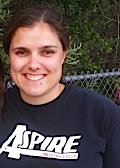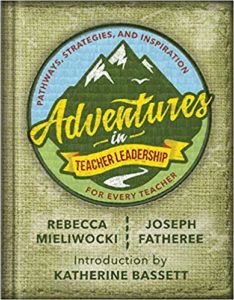A Roadmap for Success in Teacher Leadership
Adventures in Teacher Leadership
By Rebecca Mieliwocki and Joseph Fatheree
(ASCD, 2019 – Learn more)
 Reviewed by Michelle Voelker
Reviewed by Michelle Voelker
Have you ever wondered what it takes to be a State Teacher of the Year? Wondered what propels those phenomenal teachers to the next level? Lucky for you, two State Teachers of the Year have created an essential guide to help other teachers find their inner leader and achieve greatness.
Adventures in Teacher Leadership by Rebecca Mieliwocki (the 2012 NTOY) and Joseph Fatheree (a Top 10 finalist in the Global Teacher Prize) is brief yet packed with how-to’s for any situation a teacher leader might encounter. Practical, concise, and at times humorous, this book has something for any type of teacher leadership role.

With only five chapters, each dedicated to a different aspect of teacher leadership, a teacher could flip to a chapter as needed, much like a pocket guide, and discover practical ways of communicating (chapter one), collaborating (chapter two), creating professional development (chapter three), using research and data to steer your leadership (chapter four), and becoming an advocate to strengthen the profession (chapter five).
The authors know that teacher leaders have unique challenges, so they have written a book that provides a variety of techniques for any leadership situation in which you might find yourself.
Hear what has worked for State TOYs and how to adapt it
Each chapter follows a similar format: anecdotes with specific situations that three different State Teachers of the Year encountered, pages of strategies teachers can use to effectively lead in a variety of situations, pitfalls a teacher leader might face, and testimony from the same teachers featured at the beginning of the chapter, helping tie the whole idea together. Each chapter is short (the entire book is 126 pages) and the format helps make the book even more accessible.
Reading anecdotes about successful teachers who have faced experiences we can relate to – as well as reading their actual testimony – is a useful way to put some of the leadership theories into a more practical context. Within the chapters are headings that help you narrow your focus as you search for the strategy that best suits your needs and will guide you to your leadership destination.
Bring communication and collaboration together
Chapters one and two have some similar themes, mainly focusing on communication and collaboration. These chapters highlight ways that teacher leaders can help others break out of their “teacher silos.” These are relevant chapters in that no matter what type of teacher you are, it’s easy to feel isolated. Mieliwocki and Fatheree recognize that and provide thirty pages of strategies to help us communicate and collaborate with peers and administration effectively.
Strategies include simple things like inviting other teachers into your room to see you teach and connecting with other teachers on social media, to more in-depth strategies like managing a wide array of personalities while reminding us that we don’t need to become an expert in everything – that is why we collaborate!
When you’re providing PD
Chapter three focuses on creating professional development. As teacher leaders, we are expected to share what we know with others. The authors have tips to help you succeed in this arena. Building on the earlier chapters’ emphasis on creating strong relationships, chapter three takes us down the path of using the strengths of those around us, giving teachers choice over what they want to learn, and making sure that student needs drive the choices we make.
The route we travel in chapter three is more specific than some might require, but as we continue to build teams of teachers both at our school sites and on social media platforms, it is worth noting the strategies that will help to pass good information along to others.
Putting data to work
Map reading is covered in chapter four. The maps that Mieliwocki and Fatheree want us to learn to read are of course those charted by analyzing student data. The authors argue that once a teacher leader identifies a problem, they can then begin to use the correct type of data to help drive a solution.
They remind us not to shy away from this type of leadership simply because we may not be the most experienced when it comes to using data, and to make sure we highlight our success stories as a type of data worth sharing. The authors encourage us to continue to use the data to chart our teaching and highlight site-level stories, while we stretch to contribute on a larger scale, all the way to federal policy decisions made because teacher leaders contributed what they’ve learned.
Advocating for teacher voices
Finally, chapter five: the end of our pocket guide, but the beginning of our teacher leader journey. This chapter focuses on advocacy to amplify teacher voices. Mieliwocki and Fatheree provide the rationale for this type of teacher leader, and the ways that such a leader can succeed.
The authors argue that each of us will experience (or may have already experienced) a call to action. This chapter is focused on showing you how the skills outlined in the previous chapters will prepare you for your call to action. It could be site, district, state, or even nationwide, but you’ll be ready thanks to your ability to communicate, collaborate, show others the way, and to analyze data to make your case.
So, whether you’re like me, a new teacher leader, or just want a glimpse into how State Teachers of the Year make the magic happen, this is the book for you. It can easily be read in one sitting, though I suspect it will be a handy pocket resource, sharing space with other great titles on teachers’ bookshelves for years to come.
Michelle Voelker is a 7th grade English and World History teacher at an urban school in Sacramento, CA. She is a fellow with Area 3 Writing Project, a branch of the National Writing Project, and provides workshops on writing in the history classroom. Before becoming a teacher, Michelle was an AmeriCorps member for a program that provided reading intervention on Title I elementary campuses. Since then, she has worked to make sure that every kid has access to literacy and becomes a lifelong reader.



































